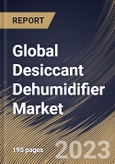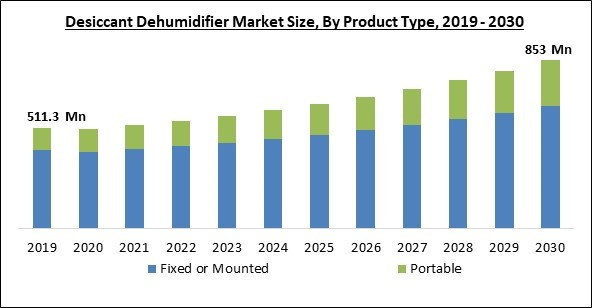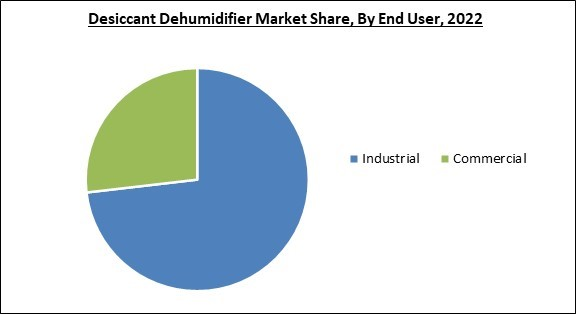The Global Desiccant Dehumidifier Market size is expected to reach $853 Million by 2030, rising at a market growth of 5.9% CAGR during the forecast period.
The construction sector uses dehumidifiers to keep the cement, iron bars, and iron rods dry. Therefore, the construction sector captured $58.5 million revenue in the market in 2022. Over half of the world's population, or 68%, will live in cities by 2050. Urbanization, or the steady transfer of people from rural to urban regions, is predicted to result in 2.5 billion more people living in urban areas by the year 2050. According to a new United Nations statistic issued in 2018, Asia and Africa would account for over 90% of this rise. There will be a significant rise in building activity worldwide as a result of this rising urbanization. Dehumidifiers are often used in the building sector to dry slabs and plasters, keep hardware shops in good condition, and stop mold development. The rising building activity in the area is likely to accelerate industrialization. Some of the factors impacting the market are evolving desiccant dehumidifier technology, usage of desiccant dehumidifiers in more sectors, and high cost and high energy consumption.
Recent developments in desiccant dehumidification technology, such as liquid desiccant dehumidification technology, are drawing more and more interest because of how well they use low-grade heat. The ability to separately adjust temperature and humidity has led to the development of energy-efficient air conditioning systems, which are superior to the conventional vapor compression type system. These desiccants are thought to be the most cutting-edge materials for thermally powered dehumidifiers in the future. Pharmaceutical, food and beverage, electronics manufacturing, chemical industries, and building sites are the main settings for desiccant dehumidifiers. Regardless of the ambient air quality, effective and consistent humidity management improves production line efficiency, yields, and waste reduction in the pharmaceutical industry. Desiccant dehumidifiers are used to regulate the moisture level to stop building delays and deal with moisture problems.
However, homeowners install dehumidifiers to decrease indoor humidity, enhance air quality, and minimize the danger of mold growth. The apparatus extracts moisture from the air, gathers it, and drains it out. The portable form, which can be moved from one location to another as required, is preferred by many. Therefore, it is projected that the dehumidifier market will not develop throughout the projection period due to the high cost of the product.
The market research report covers the analysis of key stake holders of the market. Key companies profiled in the report include Parker Hannifin Corporation, Trane Technologies PLC, Atlas Copco AB, SPX Flow, Inc., Sullair, LLC (Hitachi Group), Condair Group AG, Airwatergreen AB, Sunpentown, Inc., Fisen Corporation and Trotec GmbH (Dantherm Group) (Deutsche Beteiligungs AG).
The construction sector uses dehumidifiers to keep the cement, iron bars, and iron rods dry. Therefore, the construction sector captured $58.5 million revenue in the market in 2022. Over half of the world's population, or 68%, will live in cities by 2050. Urbanization, or the steady transfer of people from rural to urban regions, is predicted to result in 2.5 billion more people living in urban areas by the year 2050. According to a new United Nations statistic issued in 2018, Asia and Africa would account for over 90% of this rise. There will be a significant rise in building activity worldwide as a result of this rising urbanization. Dehumidifiers are often used in the building sector to dry slabs and plasters, keep hardware shops in good condition, and stop mold development. The rising building activity in the area is likely to accelerate industrialization. Some of the factors impacting the market are evolving desiccant dehumidifier technology, usage of desiccant dehumidifiers in more sectors, and high cost and high energy consumption.
Recent developments in desiccant dehumidification technology, such as liquid desiccant dehumidification technology, are drawing more and more interest because of how well they use low-grade heat. The ability to separately adjust temperature and humidity has led to the development of energy-efficient air conditioning systems, which are superior to the conventional vapor compression type system. These desiccants are thought to be the most cutting-edge materials for thermally powered dehumidifiers in the future. Pharmaceutical, food and beverage, electronics manufacturing, chemical industries, and building sites are the main settings for desiccant dehumidifiers. Regardless of the ambient air quality, effective and consistent humidity management improves production line efficiency, yields, and waste reduction in the pharmaceutical industry. Desiccant dehumidifiers are used to regulate the moisture level to stop building delays and deal with moisture problems.
However, homeowners install dehumidifiers to decrease indoor humidity, enhance air quality, and minimize the danger of mold growth. The apparatus extracts moisture from the air, gathers it, and drains it out. The portable form, which can be moved from one location to another as required, is preferred by many. Therefore, it is projected that the dehumidifier market will not develop throughout the projection period due to the high cost of the product.
End-User Outlook
By end-user, the market is bifurcated into commercial and industrial. In 2022, the industrial segment held the highest revenue share in the market. This is because desiccant dehumidifiers have various uses in industries including electronics, manufacturing, food and beverage, and energy and utility. Additionally, compared to other methods, such as refrigerant dehumidifiers, desiccant dehumidifiers provide better flexibility and need less maintenance while still providing excellent humidity management in a cost- and energy-efficient way. This gives businesses the option to choose a desiccant dehumidifier for their spaces. These elements are accelerating market expansion.Product Type Outlook
Based on product type, the market is segmented into fixed or mounted and portable. In 2022, the fixed or mounted segment led the market by generating the maximum revenue share. This may be ascribed to the increasing global growth of industrial facilities, distribution centers, water treatment plants, and lithium-ion battery manufacturing facilities. Large desiccant dehumidifiers are needed for these factories and facilities. However, they cannot be transported due to the size of the region. Fixed desiccant dehumidifiers offer a bigger capacity, centralized operation, and a longer lifetime. Compared to refrigerant-based dehumidifiers, fixed desiccant dehumidifiers have fewer moving components.Application Outlook
On the basis of application, the market is divided into energy, food & pharmaceutical, electronics, chemical, and construction. The chemical segment garnered a substantial revenue share in the market in 2022. Chemical plant's humidity level is managed using a desiccant dehumidifier. The equipment in the factory may corrode and rust due to the high humidity level. The dehumidifier eliminates moisture from the air and keeps the plant's humidity level at the optimum level. This prolongs the equipment's life and lessens corrosion. The dehumidifier also aids in preventing the degradation of the plant's goods by excessive humidity levels. With little chance of rotting, the items will stay safe for eating and fresh.Regional Outlook
Region wise, the market is analyzed across North America, Europe, Asia Pacific, and LAMEA. The North America region witnessed the largest revenue share in the market in 2022. It is projected that the rapid development of homes, businesses, and warehouses will drive the local market's growth. A healthy environment's advantages are becoming more widely known, which is good for the local market's growth. Recent private building projects created private dwellings and non-residential constructions, with some of the greatest amounts ever recorded in the United States. Two businesses earned sizable revenues among the 50 largest building contractors in the country. Dehumidifier demand is therefore rising, fueling the expansion of market revenue.The market research report covers the analysis of key stake holders of the market. Key companies profiled in the report include Parker Hannifin Corporation, Trane Technologies PLC, Atlas Copco AB, SPX Flow, Inc., Sullair, LLC (Hitachi Group), Condair Group AG, Airwatergreen AB, Sunpentown, Inc., Fisen Corporation and Trotec GmbH (Dantherm Group) (Deutsche Beteiligungs AG).
Scope of the Study
By Product Type
- Fixed or Mounted
- Portable
By Application
- Energy
- Food
- Pharmaceutical
- Construction
- Chemical
- Electronics
By End-user
- Industrial
- Commercial
By Geography
- North America
- US
- Canada
- Mexico
- Rest of North America
- Europe
- Germany
- UK
- France
- Russia
- Spain
- Italy
- Rest of Europe
- Asia Pacific
- China
- Japan
- India
- South Korea
- Singapore
- Malaysia
- Rest of Asia Pacific
- LAMEA
- Brazil
- Argentina
- UAE
- Saudi Arabia
- South Africa
- Nigeria
- Rest of LAMEA
Key Market Players
List of Companies Profiled in the Report:
- Parker Hannifin Corporation
- Trane Technologies PLC
- Atlas Copco AB
- SPX Flow, Inc.
- Sullair, LLC (Hitachi Group)
- Condair Group AG
- Airwatergreen AB
- Sunpentown, Inc.
- Fisen Corporation
- Trotec GmbH (Dantherm Group) (Deutsche Beteiligungs AG)
Unique Offerings
- Exhaustive coverage
- The highest number of Market tables and figures
- Subscription-based model available
- Guaranteed best price
- Assured post sales research support with 10% customization free
Table of Contents
Chapter 1. Market Scope & Methodology
Chapter 2. Market Overview
Chapter 3. Global Desiccant Dehumidifier Market by Product Type
Chapter 4. Global Desiccant Dehumidifier Market by Application
Chapter 5. Global Desiccant Dehumidifier Market by End User
Chapter 6. Global Desiccant Dehumidifier Market by Region
Chapter 7. Company Profiles
Companies Mentioned
- Parker Hannifin Corporation
- Trane Technologies PLC
- Atlas Copco AB
- SPX Flow, Inc.
- Sullair, LLC (Hitachi Group)
- Condair Group AG
- Airwatergreen AB
- Sunpentown, Inc.
- Fisen Corporation
- Trotec GmbH (Dantherm Group) (Deutsche Beteiligungs AG)
Methodology

LOADING...










